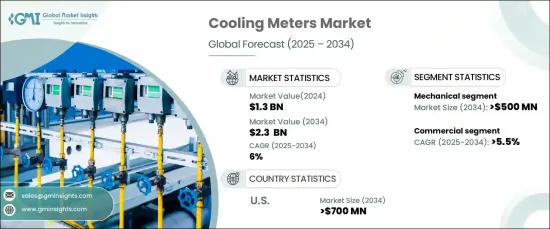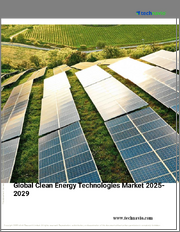
|
시장보고서
상품코드
1666895
냉각 미터 시장 기회, 성장 촉진요인, 산업 동향 분석, 예측(2025-2034년)Cooling Meters Market Opportunity, Growth Drivers, Industry Trend Analysis, and Forecast 2025 - 2034 |
||||||
세계의 냉각 미터 시장은 2024년에 13억 달러로 평가되며, 2025-2034년에 CAGR 6%로 안정적으로 성장할 것으로 예측됩니다. 냉각 미터는 공조, 냉동, 지역냉방 네트워크 등의 시스템에서 냉각 에너지 소비량 및 냉각 속도를 측정하는 데 사용되는 중요한 장비로 온도, 유량, 에너지 사용량 등의 매개변수를 모니터링하는 데 중요한 역할을 합니다.

이러한 장비는 냉각 효율과 에너지 관리를 최적화하는 데 도움이 되므로 에너지에 민감한 산업 및 건물에서 점점 더 필수적인 요소가 되고 있습니다. 에너지 비용 상승과 환경 문제에 대한 우려로 인해 에너지 효율이 높은 시스템에 대한 수요가 증가함에 따라 냉각 계량기는 지속가능성을 위한 노력에 필수적인 요소로 자리 잡고 있습니다. 또한 기술 혁신이 진행됨에 따라 이러한 장비의 기능성과 매력이 강화되어 다양한 분야에서 더 많은 채택이 이루어지고 있습니다. 또한 에너지 소비를 줄이기 위한 엄격한 규제와 함께 기후 변화에 대한 인식이 높아지면서 시장 확대에 기여하고 있습니다.
| 시장 범위 | |
|---|---|
| 시작연도 | 2024년 |
| 예측연도 | 2025-2034년 |
| 시작 금액 | 13억 달러 |
| 예상 금액 | 23억 달러 |
| CAGR | 6% |
냉각 계량기 시장은 기술에 따라 기계식 및 고정식 계량기로 나뉩니다. 기계식 부문은 2034년까지 5억 달러 규모 시장을 창출할 것으로 예상됩니다. 이러한 성장은 냉수 유량과 온도 차이를 직접 측정하는 기계식 냉각 계량기의 효율적이고 비용 효율적이며 신뢰할 수 있는 설계에 기인합니다. 이러한 계량기는 첨단 스마트 기술이 필요하지 않은 환경에서 특히 인기가 높으며, LEED와 같은 친환경 인증을 추구하는 주거 및 상업용 건물에 널리 채택되어 시장 수요를 더욱 증가시키고 있습니다.
용도에 따라 냉각 계량기 시장은 주거용, 상업용, 산업용 부문으로 구분됩니다. 상업 부문은 2034년까지 연평균 5.5%의 성장률을 보일 것으로 예상됩니다. 기업 및 상업 공간이 에너지 효율을 개선하고 운영 비용을 절감할 수 있는 방법을 모색함에 따라 사무실, 쇼핑몰, 호텔에서 냉각 계량기에 대한 수요는 계속 증가하고 있습니다. 특히 에너지 집약적인 냉방 시스템이 환경에 미치는 영향을 줄이기 위한 지속가능한 솔루션을 찾는 기업의 요구로 인해 냉각 계량기는 이러한 공간에서 점점 더 많이 사용되고 있으며, 에너지 사용을 최적화하는 데 도움이 되고 있습니다.
미국에서는 2034년까지 냉각 계량기 시장이 7억 달러 규모 시장을 창출할 것으로 예상됩니다. 이러한 성장을 지원하는 것은 기후 변화에 대응하기 위한 첨단 건축 기준의 채택과 같은 지속가능한 건축 관행을 장려하는 정부의 인센티브와 노력입니다. 또한 에너지 최적화 및 비용 절감 가능성에 대한 기업과 소비자의 인식이 높아진 것도 시장 확대의 원동력이 되고 있습니다. 이러한 시장 동향과 발전으로 인해 냉각 계량기는 앞으로도 냉방 에너지 소비를 최적화하는 데 중요한 역할을 할 것으로 보입니다.
목차
제1장 조사 방법과 조사 범위
- 조사 디자인
- 기본 추정과 계산
- 예측 모델
- 1차 조사와 검증
- 1차 정보
- 데이터 마이닝 소스
- 시장 정의
제2장 개요
제3장 업계 인사이트
- 업계 에코시스템
- 규제 상황
- 업계에 대한 영향요인
- 촉진요인
- 업계의 잠재적 리스크 & 과제
- 성장 가능성 분석
- Porter의 산업 분석
- 공급 기업의 교섭력
- 바이어의 교섭력
- 신규 진출업체의 위협
- 대체품의 위협
- PESTEL 분석
제4장 경쟁상황
- 서론
- 전략 대시보드
- 혁신과 테크놀러지 전망
제5장 시장 규모·예측 : 제품별, 2021-2034년
- 주요 동향
- 초음파
- 소용돌이
- 기타
제6장 시장 규모·예측 : 기술별, 2021-2034년
- 주요 동향
- 기계식
- 정지
제7장 시장 규모·예측 : 용도별, 2021-2034년
- 주요 동향
- 주택용
- 상업용
- 대학
- 오피스 빌딩
- 관공청 빌딩
- 기타
- 산업용
제8장 시장 규모·예측 : 지역별, 2021-2034년
- 주요 동향
- 북미
- 미국
- 캐나다
- 유럽
- 독일
- 폴란드
- 스웨덴
- 이탈리아
- 프랑스
- 아시아태평양
- 중국
- 일본
- 한국
- 싱가포르
- 인도
- 중동
- 사우디아라비아
- UAE
- 카타르
- 오만
- 쿠웨이트
제9장 기업 개요
- Axioma Metering
- Danfoss
- Diehl Stiftung &Co. KG
- Honeywell International Inc.
- Integra
- Itron Inc.
- ista Energy Solutions Limited
- Kamstrup
- Landis+Gyr
- RB Flowmeter
- Schneider Electric
- Secure Meters Ltd.
- Siemens
- Smartdhome Srl
- Sontex SA
- Xylem
- ZENNER International GmbH &Co. KG
The Global Cooling Meters Market was valued at USD 1.3 billion in 2024 and is projected to grow at a steady CAGR of 6% from 2025 to 2034. Cooling meters, crucial devices used to measure cooling energy consumption or cooling rates in systems like air conditioning, refrigeration, and district cooling networks, play a vital role in monitoring parameters such as temperature, flow rate, and energy usage.

These devices help optimize cooling efficiency and energy management, making them increasingly indispensable in energy-conscious industries and buildings. As the demand for energy-efficient systems grows, driven by rising energy costs and environmental concerns, cooling meters are becoming an essential part of sustainability efforts. Additionally, ongoing innovations in technology continue to enhance the functionality and appeal of these devices, further driving their adoption across various sectors. Increasing awareness about climate change, along with more stringent regulations aimed at reducing energy consumption, also contributes to the market's expansion.
| Market Scope | |
|---|---|
| Start Year | 2024 |
| Forecast Year | 2025-2034 |
| Start Value | $1.3 Billion |
| Forecast Value | $2.3 Billion |
| CAGR | 6% |
The market is divided into mechanical and static cooling meters based on technology. The mechanical segment is expected to generate USD 500 million by 2034. This growth can be attributed to the efficient, cost-effective, and reliable design of mechanical cooling meters, which directly measure the flow of chilled water and temperature differences. These meters are particularly popular in settings where advanced smart technologies are not necessary. They are widely adopted in residential and commercial buildings that aim for green certifications, such as LEED, which further strengthens their market demand.
When considering applications, the cooling meters market is segmented into residential, commercial, and industrial sectors. The commercial sector is projected to grow at a CAGR of 5.5% through 2034. As businesses and commercial spaces look for ways to improve energy efficiency and reduce operational costs, the demand for cooling meters in offices, malls, and hotels continues to rise. Cooling meters are increasingly used in these spaces to help optimize energy usage, especially as companies look for sustainable solutions to mitigate the environmental impact of energy-intensive cooling systems.
In the U.S., the cooling meters market is expected to generate USD 700 million by 2034. This growth is supported by government incentives and initiatives promoting sustainable building practices, such as the adoption of advanced building codes aimed at addressing climate change. The increasing awareness among businesses and consumers about energy optimization and the potential for cost savings is also driving market expansion. With these market trends and developments, cooling meters are poised to continue playing a crucial role in optimizing cooling energy consumption in the years ahead.
Table of Contents
Chapter 1 Methodology & Scope
- 1.1 Research design
- 1.2 Base estimates & calculations
- 1.3 Forecast model
- 1.4 Primary research & validation
- 1.4.1 Primary sources
- 1.4.2 Data mining sources
- 1.5 Market definitions
Chapter 2 Executive Summary
- 2.1 Industry synopsis, 2021 – 2034
Chapter 3 Industry Insights
- 3.1 Industry ecosystem
- 3.2 Regulatory landscape
- 3.3 Industry impact forces
- 3.3.1 Growth drivers
- 3.3.2 Industry pitfalls & challenges
- 3.4 Growth potential analysis
- 3.5 Porter's analysis
- 3.5.1 Bargaining power of suppliers
- 3.5.2 Bargaining power of buyers
- 3.5.3 Threat of new entrants
- 3.5.4 Threat of substitutes
- 3.6 PESTEL analysis
Chapter 4 Competitive landscape, 2024
- 4.1 Introduction
- 4.2 Strategic dashboard
- 4.3 Innovation & technology landscape
Chapter 5 Market Size and Forecast, By Product, 2021 – 2034 (USD Million & ‘000 Units)
- 5.1 Key trends
- 5.2 Ultrasonic
- 5.3 Vortex
- 5.4 Others
Chapter 6 Market Size and Forecast, By Technology, 2021 – 2034 (USD Million & ‘000 Units)
- 6.1 Key trends
- 6.2 Mechanical
- 6.3 Static
Chapter 7 Market Size and Forecast, By Application, 2021 – 2034 (USD Million & ‘000 Units)
- 7.1 Key trends
- 7.2 Residential
- 7.3 Commercial
- 7.3.1 College/University
- 7.3.2 Office building
- 7.3.3 Government building
- 7.3.4 Others
- 7.4 Industrial
Chapter 8 Market Size and Forecast, By Region, 2021 – 2034 (USD Million & ‘000 Units)
- 8.1 Key trends
- 8.2 North America
- 8.2.1 U.S.
- 8.2.2 Canada
- 8.3 Europe
- 8.3.1 Germany
- 8.3.2 Poland
- 8.3.3 Sweden
- 8.3.4 Italy
- 8.3.5 France
- 8.4 Asia Pacific
- 8.4.1 China
- 8.4.2 Japan
- 8.4.3 South Korea
- 8.4.4 Singapore
- 8.4.5 India
- 8.5 Middle East
- 8.5.1 Saudi Arabia
- 8.5.2 UAE
- 8.5.3 Qatar
- 8.5.4 Oman
- 8.5.5 Kuwait
Chapter 9 Company Profiles
- 9.1 Axioma Metering
- 9.2 Danfoss
- 9.3 Diehl Stiftung & Co. KG
- 9.4 Honeywell International Inc.
- 9.5 Integra
- 9.6 Itron Inc.
- 9.7 ista Energy Solutions Limited
- 9.8 Kamstrup
- 9.9 Landis+Gyr
- 9.10 RB Flowmeter
- 9.11 Schneider Electric
- 9.12 Secure Meters Ltd.
- 9.13 Siemens
- 9.14 Smartdhome Srl
- 9.15 Sontex SA
- 9.16 Xylem
- 9.17 ZENNER International GmbH & Co. KG



















